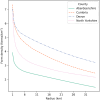Modeling target-density-based cull strategies to contain foot-and-mouth disease outbreaks
- PMID: 38436010
- PMCID: PMC10909358
- DOI: 10.7717/peerj.16998
Modeling target-density-based cull strategies to contain foot-and-mouth disease outbreaks
Abstract
Total ring depopulation is sometimes used as a management strategy for emerging infectious diseases in livestock, which raises ethical concerns regarding the potential slaughter of large numbers of healthy animals. We evaluated a farm-density-based ring culling strategy to control foot-and-mouth disease (FMD) in the United Kingdom (UK), which may allow for some farms within rings around infected premises (IPs) to escape depopulation. We simulated this reduced farm density, or "target density", strategy using a spatially-explicit, stochastic, state-transition algorithm. We modeled FMD spread in four counties in the UK that have different farm demographics, using 740,000 simulations in a full-factorial analysis of epidemic impact measures (i.e., culled animals, culled farms, and epidemic length) and cull strategy parameters (i.e., target farm density, daily farm cull capacity, and cull radius). All of the cull strategy parameters listed above were drivers of epidemic impact. Our simulated target density strategy was usually more effective at combatting FMD compared with traditional total ring depopulation when considering mean culled animals and culled farms and was especially effective when daily farm cull capacity was low. The differences in epidemic impact measures among the counties are likely driven by farm demography, especially differences in cattle and farm density. To prevent over-culling and the associated economic, organizational, ethical, and psychological impacts, the target density strategy may be worth considering in decision-making processes for future control of FMD and other diseases.
Keywords: Disease modeling; Emerging infectious diseases; Farm demography; Foot-and-mouth disease; Host density; Livestock disease; Ring culling.
© 2024 Seibel et al.
Conflict of interest statement
Amanda J. Meadows is employed by Ginkgo Bioworks.
Figures






Similar articles
-
One-size measures do not fit all areas: Evaluation of area-specific control of foot and mouth disease in Thailand using bioeconomic modelling.Prev Vet Med. 2024 Dec;233:106359. doi: 10.1016/j.prevetmed.2024.106359. Epub 2024 Oct 16. Prev Vet Med. 2024. PMID: 39437627
-
Evaluation of foot and mouth disease control measures: Simulating two endemic areas of Thailand.Prev Vet Med. 2023 Nov;220:106045. doi: 10.1016/j.prevetmed.2023.106045. Epub 2023 Oct 11. Prev Vet Med. 2023. PMID: 37866130
-
Mathematical model of the 2010 foot-and-mouth disease epidemic in Japan and evaluation of control measures.Prev Vet Med. 2013 Nov 1;112(3-4):183-93. doi: 10.1016/j.prevetmed.2013.08.010. Epub 2013 Aug 30. Prev Vet Med. 2013. PMID: 24034814
-
Foot-and-Mouth disease control using vaccination: the Dutch experience in 2001.Dev Biol (Basel). 2004;119:41-9. Dev Biol (Basel). 2004. PMID: 15742617 Review.
-
Destructive tension: mathematics versus experience--the progress and control of the 2001 foot and mouth disease epidemic in Great Britain.Rev Sci Tech. 2011 Aug;30(2):483-98. doi: 10.20506/rst.30.2.2054. Rev Sci Tech. 2011. PMID: 21961220 Review.
Cited by
-
Modeling foot-and-mouth disease dissemination in Rio Grande do Sul, Brazil and evaluating the effectiveness of control measures.Front Vet Sci. 2024 Oct 25;11:1468864. doi: 10.3389/fvets.2024.1468864. eCollection 2024. Front Vet Sci. 2024. PMID: 39564186 Free PMC article.
-
Epidemiology and economics of foot-and-mouth disease: current understanding and knowledge gaps.Vet Res. 2025 Jul 7;56(1):141. doi: 10.1186/s13567-025-01561-5. Vet Res. 2025. PMID: 40624570 Free PMC article. Review.
-
Modelling the Spread of Foot and Mouth Disease in Different Livestock Settings in Italy to Assess the Cost Effectiveness of Potential Control Strategies.Animals (Basel). 2025 Jan 29;15(3):386. doi: 10.3390/ani15030386. Animals (Basel). 2025. PMID: 39943156 Free PMC article.
References
-
- Department for Environment, Food and Rural Affairs of the United Kingdom Foot and mouth disease control strategy for Great Britain. 2011. https://assets.publishing.service.gov.uk/government/uploads/system/uploa.... [3 November 2020]. https://assets.publishing.service.gov.uk/government/uploads/system/uploa...
MeSH terms
Associated data
LinkOut - more resources
Full Text Sources

